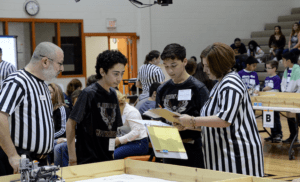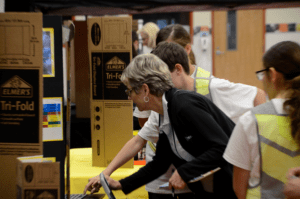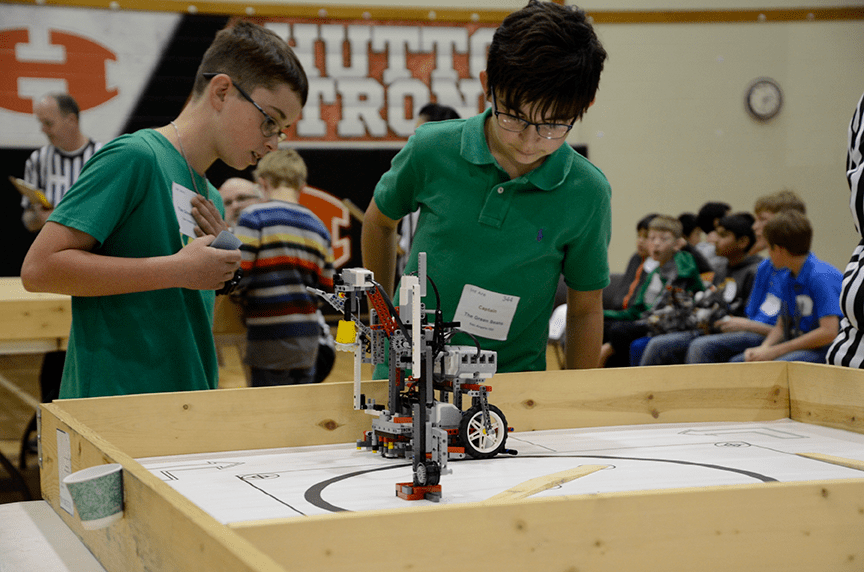Students from across the state gathered this past weekend to participate in the annual TCEA State Robotics Contest. Teams had the opportunity to put their collaborative critical-thinking skills to the test as they showcased their inventions and went head-to-head with other state finalists in the Arena division. Two hundred teams of up to four students each gathered in Hutto to test their skills. Each team had already competed at the Area level against more than 1,400 teams.
Arena Contest
 This year’s challenge, Mastering Mars, allowed students the opportunity to task their robots to prepare the Martian environment for human settlement and iron mining. Each team’s robot had to complete as many tasks as they could within the two-minute time frame. Teams were allowed to use one LEGO Mindstorms programmable processing unit, LEGO-branded motors and sensors, other LEGO-branded devices, and non-LEGO parts not to exceed the five dollar limit.
This year’s challenge, Mastering Mars, allowed students the opportunity to task their robots to prepare the Martian environment for human settlement and iron mining. Each team’s robot had to complete as many tasks as they could within the two-minute time frame. Teams were allowed to use one LEGO Mindstorms programmable processing unit, LEGO-branded motors and sensors, other LEGO-branded devices, and non-LEGO parts not to exceed the five dollar limit.
It was impressive to see both Intermediate (grades 4-8) and Advanced (grades 9-12) state teams put their problem-solving skills to the test as they attempted to complete each task on the game field. Anticipation mixed with excitement filled the room as teams watched in awe as their robots performed. One contestant in the Arena Pit mentioned being able to test the robot’s capabilities and see what it can and can’t do as part of the thrill of competing. Overall, a great sense of teamwork, problem-solving, and creativity radiated throughout the groups.
Inventions Contest
 As Arena contestants battled it out for the top spot, Invention participants exercised their creative-thinking skills by designing a robot to solve a real-world problem of their own choosing. From iPotty toilet assistance for the elderly to oil pipe sealing robots, students of all ages let their imaginations run free to create exciting solutions to make the world a better place. Other solutions offered to save lives, assist entomologists to gather insect specimens, and collect dangerous metal objects, among others.
As Arena contestants battled it out for the top spot, Invention participants exercised their creative-thinking skills by designing a robot to solve a real-world problem of their own choosing. From iPotty toilet assistance for the elderly to oil pipe sealing robots, students of all ages let their imaginations run free to create exciting solutions to make the world a better place. Other solutions offered to save lives, assist entomologists to gather insect specimens, and collect dangerous metal objects, among others.
In addition to providing functional prototypes of their creations, Inventions teams had to keep a detailed logbook of their progress and come up with polished presentations and marketing plans for their ideas. When asked what was their favorite part of competing at the state level, an intermediate team agreed it was the ability to create new initiatives through their inventions while being able to assist others in the process.
I hope this insider’s look into this year’s competition encourages you to incorporate robotics into your classroom while allowing your students to develop their problem-solving and critical thinking skills further. If you’re interested in learning more about our program and how your students can join other robotics teams next year, click here. You might also want to check out the amazing EV3 robotics workshop TCEA is offering July 16-20. This five-day robotics workshop will show you how to use LEGO MINDSTORMS to help your students develop a love of STEM along with valuable critical thinking, problem-solving, and collaboration skills. Whether you’re an educator, librarian, or administrator, this week-long learning opportunity will give you the knowledge, resources, and best practices to introduce a successful robotics program at your school this fall.

